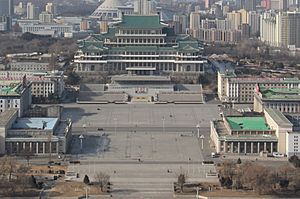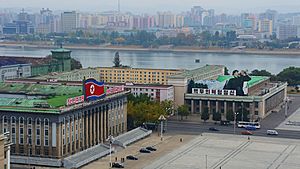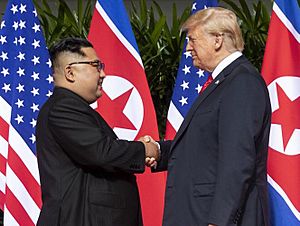Kim Il-sung Square facts for kids
| Kim Il-sung Square | |
 |
|
Quick facts for kids Korean name |
|
|---|---|
| Chosŏn'gŭl |
김일성광장
|
| Hancha | |
| Revised Romanization | Gim Il-seong Kwangjang |
| McCune–Reischauer | Kim Il-sŏng Kwangjang |
Kim Il-sung Square is a very big city square in Pyongyang, the capital city of North Korea. It is named after Kim Il-sung, who was the first leader of the country.
The square was built in 1954. It was part of a big plan to rebuild Pyongyang after the Korean War caused a lot of damage. It officially opened in August 1954. You can find the square on the west side of the Taedong River, near Namsan Hill. It is directly across the river from the famous Juche Tower.
Kim Il-sung Square is the 37th largest square in the world. It covers about 75,000 square meters (807,293 square feet). This huge space can hold more than 100,000 people at once. The square is very important to North Korea's culture. It is a common place for big events, like rallies, dances, and military parades. You often see it in news and pictures about North Korea.
Contents
What Makes Kim Il-sung Square Special?
This square is much like Tiananmen Square in Beijing, China. It is used for similar events and gatherings. Since it was finished, many parades have been held here. These parades celebrate different events and also show the world North Korea's military power.
The design of Kim Il-sung Square is quite impressive. It has a dramatic setting right by the river. If you stand in the square, the Tower of the Juche Idea on the other side of the river looks like it is at the far end of the square. This cool trick happens because the middle of the square is a few meters lower than the parts closer to the river.
Around the square, you will see many government buildings. The Great People's Study House is at the "head" of the square. It is a very important building.
Buildings around the square display large portraits of Kim Il-sung and Kim Jong-il. These portraits used to show Karl Marx and Vladimir Lenin. When Kim Jong-il was alive, only Kim Il-sung's portrait was on these buildings. After Kim Jong-il passed away, his portrait was added to remember him. At the south end of the square, two flagpoles were put up in 2013. They are used for national events.
Changes to Anti-American Messages
After a meeting between President Donald Trump and Kim Jong-un in Singapore in 2018, some changes happened. North Korea removed anti-American messages from Kim Il-sung Square. Also, Pyongyang canceled its yearly 'anti-US' rally in 2018. In 2017, about 100,000 people supposedly attended these protests in the square. Pyongyang had also released special anti-US postage stamps that year.
Images for kids
See also
 In Spanish: Plaza Kim Il-sung para niños
In Spanish: Plaza Kim Il-sung para niños









